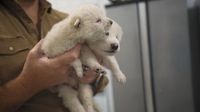In a groundbreaking announcement that seems straight out of a science fiction movie, Colossal Biosciences has successfully brought back the giant wolf of America, a species that has been extinct for over 10,000 years. This remarkable achievement marks the first instance of de-extinction in history, as the company reveals that three specimens, named Rómulo, Remo, and Khaleesi, were born in October 2024.
The giant wolf, scientifically known as Aenocyon dirus, roamed the Americas during the Pleistocene era, from the United States down to Argentina. Known for its robust build, the dire wolf had a larger frame than modern wolves, featuring shorter legs, a long snout, and powerful jaws capable of crushing bones. It lived alongside other prehistoric creatures, including mammoths and mastodons, before disappearing around 10,000 years ago.
Colossal Biosciences, a Dallas-based biotechnology firm valued at an impressive $10 billion, has been at the forefront of efforts to revive extinct species. Their journey began with aspirations to resurrect the woolly mammoth and the Tasmanian tiger but has now taken a significant leap with the birth of the giant wolves. The company has gained considerable attention for its ambitious goals, which include not only de-extinction but also potential applications in health and biodiversity.
The process behind the revival of the giant wolf involved meticulous genetic engineering. Colossal scientists extracted DNA from a tooth and jawbone of two fossils, aged between 13,000 and 72,000 years. They identified 20 critical genetic differences between the giant wolf and its closest living relative, the gray wolf. By using CRISPR technology, they edited the gray wolf's genome to incorporate these traits, effectively transforming it into a dire wolf.
Once the genome was modified, researchers implanted the edited cells into the eggs of gray wolves, leading to the successful gestation of three puppies. Rómulo and Remo, named after the legendary founders of Rome, and Khaleesi, named after the popular character from Game of Thrones, now reside in a secure animal reserve, the location of which remains undisclosed to protect them from public attention.
Each of these puppies is reported to be 20% to 25% larger than their gray wolf counterparts, with a distinctive white coat and robust physique. Their diet consists of a mix of beef, venison, horse meat, and specially formulated kibble, ensuring they receive the necessary nutrition to thrive.
The announcement has stirred excitement and intrigue within the scientific community and the public alike. In a post on social media platform X, Colossal Biosciences shared a video of the wolves howling, a sound that had not been heard for over 10,000 years. The company has also emphasized the ecological importance of reviving such species, especially in light of the ongoing biodiversity crisis, where numerous species are facing extinction.
However, the endeavor is not without its controversies. Critics have raised ethical concerns regarding the reintroduction of extinct species into modern ecosystems. While proponents argue that reintroducing species like the giant wolf could help restore ecological balance, skeptics question the practicality and consequences of such actions.
George Church, a co-founder of Colossal and a prominent figure in genetic research, has stated that the company’s work could pave the way for future de-extinction efforts. "If we succeed in de-extinction, we will be building technologies that can aid in human health care and conservation," Church remarked.
Colossal's ambitions extend beyond the giant wolf; the company aims to resurrect the woolly mammoth next, using similar genetic engineering techniques. The prospect of bringing back iconic species has captured the public's imagination and sparked discussions about the role of technology in conservation.
Despite the excitement surrounding these developments, the scientific community is awaiting peer-reviewed studies to validate Colossal's claims. As of now, no independent verification of the genetic modifications and their implications has been published, which is a standard practice in scientific research.
The birth of Rómulo, Remo, and Khaleesi represents a significant milestone in the intersection of biotechnology and conservation. As the world watches closely, the implications of this achievement could reshape our understanding of extinction and biodiversity.
In a time when many species are on the brink of extinction, the question remains: is it ethical to play god with nature? The debate continues as Colossal Biosciences forges ahead with its ambitious plans, potentially ushering in a new era for life on Earth.
Colossal has already made headlines for creating genetically modified mice with woolly mammoth traits, showcasing its commitment to pushing the boundaries of genetic research. The company has raised significant funding, totaling $435 million from various investors, including notable figures from the entertainment and tech industries.
While the giant wolf may be the first successful de-extinction, it certainly won't be the last. As Colossal Biosciences continues its quest to revive long-lost species, the future of biotechnology and conservation hangs in the balance, challenging our perceptions of life, extinction, and the ethical considerations that come with it.







